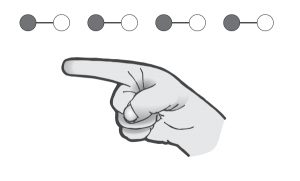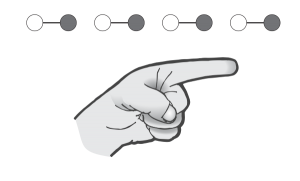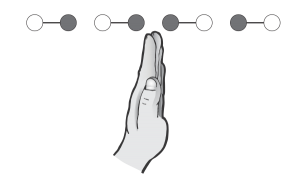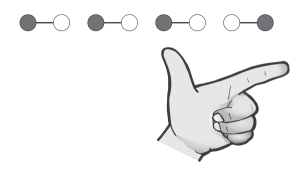Hand Game (AWG)
Objective of the Game
These rules for the Hand Game are used at the Arctic Winter Games and allow for shorter rounds of play than other variations.
Equipment
- A mat or tarp on which the players kneel or squat, is spread out on the ground.
- A blanket, jacket other cover which the players may use to conceal their hands when hiding.
- Four or more Dene drums.
- Thirty counting sticks for each team. These sticks should be finger-sized; they may be peeled or decorated.
- A small coin, a .22 shell, or some other small object to be used f must be presented before the game and used throughout the game.
Playing Area
- The mat on which the players kneel is spread on the ground.
Teams and Players
- This is a team competition with teams of four players on each team.
- For the Arctic Winter Games, each team will be accompanied by a coach who prepares the team for play, but who does not himself play.
- Each team will declare one player at a time to be the captain or pointer (guesser). The captain can be changed at any time during a game.
How to Play
Preparation
- For a four-player team, all games start with twelve sticks. The sticks are placed in the middle between the opposing teams.
- Play is started by a contest between the opposing captains, who simultaneously hide their object and signal the position of the other's object. This continues until one captain is successful while the other is not. The team whose captain wins this initial exchange, is the first to hide their objects.
Starting Position
- Teams start in a kneeling position, facing each other. Players on one team may switch positions at any time during the game.
Movement
- The drummers begin to play, signalling the beginning of the competition.
- Each player on the hiding team takes his object and, with hands behind his back, concealed under the blanket, or hidden between his thighs, shuffles it from hand to hand. Presenting the hands for the other team to see, the player attempts to deceive the opposing team's captain with elaborate gestures of the hands, arms, head and upper body. This movement takes place with all players on the team at the same time.
- Players may not cross and uncross their arms during play.
- When hiding their object, players must stay down no longer than eight seconds at most.
Signals
- Only four hand signals are used in this team competition. All players on the opposing team are guessed at the same time. The signals are shown below. As the players may present their fists with their arms extended or crossed over, the signals designate the location of the object relative to body side.
- When the captain is ready to make a call (hand signal), a loud sound must be given, such as a hand clap, a sharp whistle, or a shout such as 'Ho!' or 'Hutch!' 10 When a call is made, players on the hiding team must present both closed fists at once. They either extend their arms with their closed fists palm down, or they cross their arms over the chest so that the fists come to rest towards the shoulders. The style of presentation will differ from player to player.
- Players may touch the ground or floor and call, 'Diya!', when using the crossed-arm position to indicate opposites. In this case the captain must identify the location of the object as if the arms were not crossed (opposites).
Tallying
- Each time the captain is unsuccessful in guessing the position of an opposing player's object, he gives the player's team a stick from the middle. A player who is guessed correctly by the captain, is eliminated from the round. When a player successfully deceives the captain, he stays in the competition. Play continues until the 12 sticks placed in the middle have been given out. At this point the captains have to draw on the collection of sticks which they have won thus far.
- When all players on one team have been guessed, the right to 'play' (that is, to hide the objects) moves to the other team who then attempt to win the sticks either left in the middle, or those already won by the other team.
End of Game
- One game consists of winning two rounds of play (best of three): 12 + 12 or 24 sticks. A team winning a round will return all the sticks to the opposing team and commence the second round, with all players. A round still in progress after 15 minutes will be won by the team holding the greater number of counting sticks.
Competition Format
- Round robin, the initial pairs are determined by draw. There are no playoffs, the team that has won the most games in the competition will be declared the winner. In the case of a tie, the team who has won the most sticks in the timed competition will be declared the winner. Teams can agree to play a one-round tie-breaker instead.
Hand Signals
- The hand signals shown in the diagrams below are described from the captain's point of view (looking over his shoulder).
- Different captains have different styles for indicating the signals, but at the Arctic Winter Games they all have the same meaning. Some of the styles are shown in the photos.
Signal 1
All objects are on the left side. This signal can also be given with four fingers of the hand extended and the thumb hidden.

Signal 2
All objects are on the right side. This signal can also be given with four fingers of the hand extended and the thumb hidden.

Signal 3
Hand splits the line. All objects are hidden in the inside hand (the hand closest to the captain's pointing hand); the thumb is hidden. The captain can split the line in three different ways.

Signal 4
The hand splits the line: The objects are hidden in the outside hand. The line can be split in three different ways. This signal is sometimes also given with both hands at the same time, indicating a double split in the line.
Signals [l], [2] and [4] are also used when only one hiding player is left.

Last revised on 27 April, 2020.